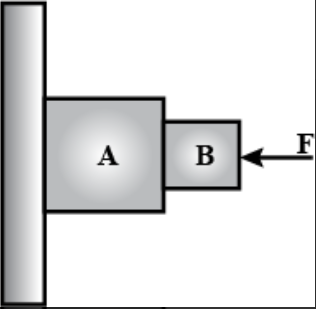Consider the system shown in the figure. The wall is smmoth, but the surfaces of blocks A and B in contact are rough. The friction on B due to A in equilibrium is

upward
downward
zero
the system cannot remain in equilibrium
The correct Answer is:B
a1=g/1 a2=g/3 a3=g/2
Topper's Solved these Questions
Similar Questions
Consider the situation shown in the figure. The wall is smooth but the surface of blocks A and B in contact are rough. The friction of B due to A in equilibrium

View SolutionConsider the situation shown in figure. The wall is smooth but the surfces of A and B in contact are rough. The friction on B due to A in equilibrium.

(a) is upward
(b) is downward
(c) is zero
(d) the system cannot remain in equilibrium
View Solution
Knowledge Check
Consider the situation shown in the figure. The wall is smooth but the surfaces of A and B in contact are rough. Then,
 Asystem may remain in equilibriumBboth bodies must move togetherCthe system cannot remain in equilibriumDNone of the above
Asystem may remain in equilibriumBboth bodies must move togetherCthe system cannot remain in equilibriumDNone of the aboveConsider the system as shown. The wall is smooth, but the surface of block A & B in contact is rough. The friction force on B due to A equilibrium is :
 AZeroBUpwardsCDownwardsDThe system cannot remain in equilibrium
AZeroBUpwardsCDownwardsDThe system cannot remain in equilibriumFigure shows two block A and B pushed against the wall with the force F . The wall is smooth but the surfaces in contact of A and B are rough. Which of the following is true for the system of blocks to be at rest againts wall?
 AF should be equal to weight of A and BBF should be less than weight of A and BCF should be more than weight of A and BDSystem connot be in rquilibrium (at rest).
AF should be equal to weight of A and BBF should be less than weight of A and BCF should be more than weight of A and BDSystem connot be in rquilibrium (at rest).
Consider the situation shown in figure. The wall and the surface of A and B in contact are rough. The friction on A due to .

View SolutionAll surfaces as shown in the figure are rough. Draw the friction force on A & B

View SolutionSuppose all the surfaces in the previous problem are rough. The direction of friction on B due to A
View Solution
All surfaces are rough . Draw the friction force on A & B
View SolutionBlocks shown in figure moves with constant velocity 20 m/s towards right. All surfaces in contact are rough. The friction force applied by B on A is

View Solution
